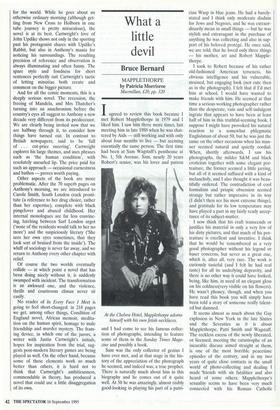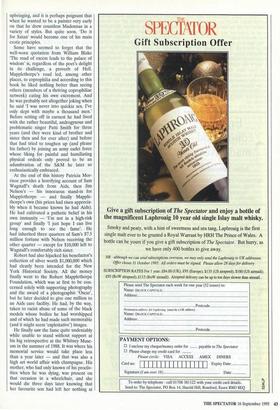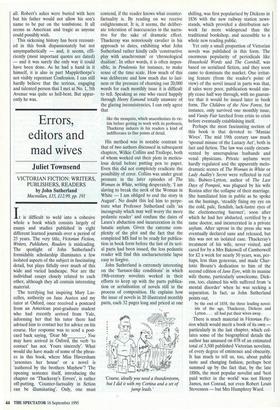What a little devil
Bruce Bernard
MAPPLETHORPE by Patricia Morrisroe Macmillan, £20, pp. 320 Iagreed to review this book because I met Robert Mapplethorpe in 1979 and I liked him. I saw him three more times, last meeting him in late 1988 when he was shat- tered by Aids — still working and with only about four months to live — but seeming essentially the same person. The first time had been at Sam Wagstaff 's penthouse at No. 1, 5th Avenue. Sam, nearly 20 years Robert's senior, was his lover and patron
At the Chelsea Hotel Mapplethorpe adorns himself with his own fetish necklaces.
and I had come to see his famous collec- tion of photographs, intending to feature some of them in the Sunday Times Maga- zine and possibly a book.
Sam was the only collector of genius I have ever met, and at that stage in the his- tory of the appreciation of the photograph he seemed, and indeed was, a true prophet. There is naturally much about him in this biography and he comes out of it quite well. At 50 he was amazingly, almost risibly good-looking in playing his part of a patri-
cian Wasp in blue jeans. He had a barely- stated and I think only moderate disdain for Jews and Negroes, and he was extraor- dinarily mean in small things — but he was stylish and extravagant in the purchase of anything he was collecting and also in sup- port of his beloved protégé. He once said, we are told, that he loved only three things — his mother, art and Robert Mapple- thorpe.
I took to Robert because of his rather old-fashioned American terseness, his obvious intelligence and his vulnerable, strained, but engaging look (not cute then as in the photograph). I felt that if I'd met him at school, I would have wanted to make friends with him. He seemed at that time a serious working photographer rather than the desperate, vain and self-indulgent ingrate that appears to have been at least half of him in this truthful-seeming book. I suppose I might have provoked his natural reaction to a somewhat phlegmatic Englishman of about 50, but he was just the same on the other occasions when his man- ner seemed natural and quietly cordial.
When, shortly afterwards, I saw his photographs, the milder S&M and black
eroticism together with some elegant por- traiture, the former seemed a little jarring, but all of it seemed suffused with a kind of melancholy, and I also thought it was beau- tifully ordered. The contradiction of cool formalism and priapic obsession seemed strange but rather impressive in its way (I didn't then see his most extreme things), and gratitude for its low temperature may have played a part in my fairly ready accep- tance of its subject-matter.
I now think that his craft transcends or justifies his material in only a very few of his dirty pictures, and that much of his por- traiture is excellent and inventive. I think that he would be remembered as a very good photographer without his legend or baser concerns, but never as a great one, which is, after all, very rare. The work is
curiously tasteful (and I felt he had real
taste) for all its underlying depravity, and there is no other way it could have looked, being, like him, in need of an elegant gloss on his coldness(very visible on his flowers). He wasn't phoney, though, and when you have read this book you will simply have been told a story of someone really talent- ed but damned.
It seems almost as much about the Gay explosion in New York in the late Sixties and the Seventies as it is about Mapplethorpe, Patti Smith and Wagstaff.'
The reckless excess of the newly liberated, or licensed, meeting the catastrophe of an incurable disease aimed straight at them, is one of the most horrible peacetime episodes of the century, and in my two years of quite close contacts in the small world of photo-collecting and dealing I made 'friends with six fatalities and also heard of some others. Mapplethorpe's sexuality seems to have been very much connected with his Roman Catholic upbringing, and it is perhaps poignant that when he wanted to be a painter .very early on that he drew countless Madonnas in a variety of styles. But quite soon, 'Do it for Satan' would become one of his main erotic principles.
Some have seemed to forget that the well-worn quotation from William Blake The road of excess leads to the palace of wisdom' is, regardless of the poet's delight in its challenge, a proverb of Hell. Mapplethorpe's road led, among other places, to coprophilia and according to this book he liked nothing better than seeing others (members of a thriving coprophiliac network) eating his own excrement. And he was probably not altogether joking when he said 'I was never into quickie sex. I've only slept with maybe a thousand men.' Before setting off in earnest he had lived with the rather beautiful, androgynous and problematic singer Patti Smith for three years (and they were kind of brother and sister then and for ever after) and before that had tried to toughen up (and please his father) by joining an army cadet force whose liking for painful and humiliating physical ordeals only proved to be an adumbration of the S&M he later so enthusiastically embraced.
At the end of this history Patricia Mor- risoe provides a horrifying account of Sam Wagstaff's death from Aids, then Jim Nelson's — his innocuous stand-in for Mapplethorpe — and finally Mapple- thorpe's own (his prices had risen apprecia- bly when it became known he had Aids). He had cultivated a pathetic belief in his own immunity — 'I'm not in a high-risk group' and finally 'I just hope I can live long enough to see the fame'. He had inherited three quarters of Sam's $7.5 million fortune with Nelson receiving the other quarter — except for $10,000 left to Wagstaff's comfortably rich sister.
Robert had also hijacked his benefactor's collection of silver worth $1,000,000 which had clearly been intended for the New York Historical Society. All the money finally went to the Robert Mapplethorpe Foundation, which was at first to be con- cerned solely with supporting photography and the award of a photographic 'Oscar', but he later decided to give one million to an Aids care facility. He had, by the way, taken to racist abuse of some of the black models whose bodies he had worshipped and of which he had made such memorable (and it might seem 'exploitative') images.
He finally saw the fame quite undeniably while unable to stand without support at his big retrospective at the Whitney Muse- um in the summer of 1988. It was where his memorial service would take place less than a year later — and that was also a high art world affair with champagne. His mother, who had only known of his procliv- ities when he was dying, was present on that occasion in a wheelchair, and she would die three days later knowing that her favourite son had left her nothing at all. Robert's ashes were buried with hers but his father would not allow his son's name to be put on the tombstone. It all seems as American and tragic as anyone could possibly wish.
This sickening history has been recount- ed in this book dispassionately but not unsympathetically — and, it seems, effi- ciently (most important quotes are dated) — and it was surely the only way it could have been done. As he had a hand in it himself, it is also in part Mapplethorpe's not visibly repentant Confession. I can still hardly believe that the serious, engaging and talented person that I met at No. 1, 5th Avenue was quite so hell-bent. But appar- ently he was.




































































 Previous page
Previous page